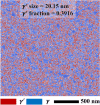Artificial intelligence inspired design of non-isothermal aging for γ-γ' two-phase, Ni-Al alloys
- PMID: 37542098
- PMCID: PMC10403502
- DOI: 10.1038/s41598-023-39589-2
Artificial intelligence inspired design of non-isothermal aging for γ-γ' two-phase, Ni-Al alloys
Abstract
In this paper, a state-of-the-art Artificial Intelligence (AI) technique is used for a precipitation hardening of Ni-based alloy to predict more flexible non-isothermal aging (NIA) and to examine the possible routes for the enhancement in strength that may be practically achieved. Additionally, AI is used to integrate with Materials Integration by Network Technology, which is a computational workflow utilized to model the microstructure evolution and evaluate the 0.2% proof stress for isothermal aging and NIA. As a result, it is possible to find enhanced 0.2% proof stress for NIA for a fixed time of 10 min compared to the isothermal aging benchmark. The entire search space for aging scheduling was ~ 3 billion. Out of 1620 NIA schedules, we succeeded in designing the 110 NIA schedules that outperformed the isothermal aging benchmark. Interestingly, it is found that early-stage high-temperature aging for a shorter time increases the γ' precipitate size up to the critical size and later aging at lower temperature increases the γ' fraction with no anomalous change in γ' size. Therefore, employing this essence from AI, we designed an optimum aging route in which we attained an outperformed 0.2% proof stress to AI-designed NIA routes.
© 2023. Springer Nature Limited.
Conflict of interest statement
The authors declare no competing interests.
Figures













References
-
- Reed, R. C. The Superalloys: Fundamentals and Applications. (Cambridge University Press, 2006).
-
- Erickson, G. L. The Development of the CMSX®-11B and CMSX®-11C Alloys for Industrial Gas Turbine Application. Superalloys. 45–52 (1996).
-
- Smith, G. D. & Patel, S. J. Superalloys, 718, 625, 706 and derivatives. TMS, Warrendale 135–54 (2005).
-
- Kracke, A. Superalloys, the most successful alloy system of modern times‐past, present, and future. Superalloys. 13–50 (2010).
-
- Sims, C. T. A history of superalloy metallurgy for superalloy metallurgists. Superalloys. 399–419 (1984).
Grants and funding
LinkOut - more resources
Full Text Sources
Research Materials

